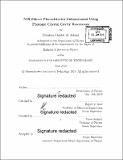| dc.contributor.advisor | Rajeev J. Ram and Marin Soljačić. | en_US |
| dc.contributor.author | Al Johani, Ebrahim Dakhil. | en_US |
| dc.contributor.other | Massachusetts Institute of Technology. Department of Physics. | en_US |
| dc.date.accessioned | 2020-11-06T21:09:00Z | |
| dc.date.available | 2020-11-06T21:09:00Z | |
| dc.date.copyright | 2019 | en_US |
| dc.date.issued | 2019 | en_US |
| dc.identifier.uri | https://hdl.handle.net/1721.1/128418 | |
| dc.description | Thesis: S.B., Massachusetts Institute of Technology, Department of Physics, 2019 | en_US |
| dc.description | Cataloged from PDF of thesis. "The Table of Contents does not accurately represent the page numbering"--Disclaimer page. | en_US |
| dc.description | Includes bibliographical references (pages 45-47). | en_US |
| dc.description.abstract | The growing demand for efficient infrared sensors for light ranging, thermal-cameras, and soon, free-space optical communications has yet to be answered. In this study, we use polycrystalline silicon in conjunction with a photonic crystal cavity (PhCC) to enhance light absorption for efficient sensing. We present a cost-effective alternative to the current III-V detectors. By adding a 2D-PhC resonator layer, surface-illuminated light can be confined within a 10 micron region with great intensity, leading to a higher effective path-length and improved detector responsivity. More than 1000 variants of this detector are designed and implemented in a 65nm CMOS process. Using a nearest neighbor method, we find the optimized designs. We validate experimental findings by simulating mode behavior of the PhCC structures using FDTD models. In addition, a numerical study on cavity parameter optimization for achieving high Q-factors and extinction ratios specifically for surface-illumination is presented. We report polysilicon PhCC-enhanced sensors with Q-factors of 6500 resulting in responsivities at 1300nm up to 0.13mA/W -a 25x improvement over non-resonant surface-illuminated Silicon detectors. | en_US |
| dc.description.statementofresponsibility | by Ebrahim Dakhil Al Johani. | en_US |
| dc.format.extent | 59 pages | en_US |
| dc.language.iso | eng | en_US |
| dc.publisher | Massachusetts Institute of Technology | en_US |
| dc.rights | MIT theses may be protected by copyright. Please reuse MIT thesis content according to the MIT Libraries Permissions Policy, which is available through the URL provided. | en_US |
| dc.rights.uri | http://dspace.mit.edu/handle/1721.1/7582 | en_US |
| dc.subject | Physics. | en_US |
| dc.title | NIR silicon photodetector enhancement using photonic crystal cavity resonators | en_US |
| dc.type | Thesis | en_US |
| dc.description.degree | S.B. | en_US |
| dc.contributor.department | Massachusetts Institute of Technology. Department of Physics | en_US |
| dc.identifier.oclc | 1203144599 | en_US |
| dc.description.collection | S.B. Massachusetts Institute of Technology, Department of Physics | en_US |
| dspace.imported | 2020-11-06T21:08:59Z | en_US |
| mit.thesis.degree | Bachelor | en_US |
| mit.thesis.department | Phys | en_US |
